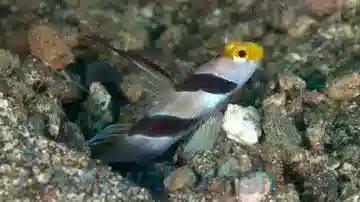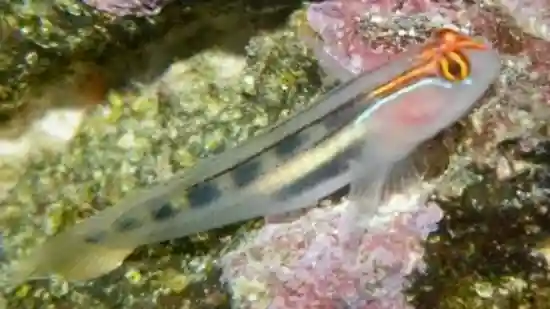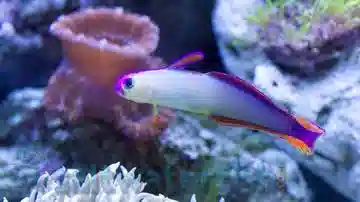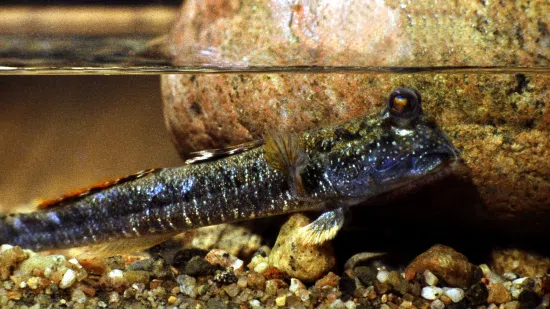Mudskipper
Periopthalmus sp.
(0 Reviews)

Mudskipper
Periopthalmus sp.
(0 Reviews)
{{ item.name }}
Size: {{ item.extra_field_3 }}
${{ getFormattedPrice(item.saleprice) }} ${{ getFormattedPrice(item.price) }}
To join the waiting list, click here
Free Shipping
With
$199.00
or more in Marine Life.
More details...
Mudskipper Care Facts
| Care Level: | Easy |
|---|---|
| Temperament: | Peaceful |
| Diet: | Carnivore |
| Reef Safe: | Yes |
| Minimum Tank Size: | 30 Gallons |
| Max Size: | 4 inches |
Mudskippers (Periopthalmus sp.) are a very unique type of fish that you don't see very often. They're a saltwater/brackish species that has it's eyes on the top of it's head and a tan/olive body with dark mottled stripes along its sides. Males will have a large sailfin on their back that they use for fighting other males and wooing females. They are unique in that they will climb on land and rocks and have more of a amphibious lifestyle then an aquatic lifestyle. They require a more specialized tank setup with a land section to climb out on, preferably with sand as they do like to sift through the sand for food particles. They will grow up to 4 inches and will require a minimum tank size of 30 gallons. Having a Mudskipper tank has many upsides being they not only look peculiar they also have outgoing personalities and will often cling to the sides of tanks begging for food. A low flow tank is preferable for them as they do not like strong currents. They are reef safe and they can be kept in groups as long as there are more females as males will fight for territory. Feed them a variety of live and frozen foods such as brine shrimp, mysis, and carnivore mix. They will also eat insects such as crickets, fruit flies, and meal worms.
Exploring the Extraordinary: Mudskipper (Periopthalmus sp.)
Mudskipper Habitat
The Mudskipper, scientifically known as Periopthalmus sp., is a unique and captivating addition to saltwater marine aquariums. Native to brackish and coastal environments, these amphibious fish are found in mangrove areas, estuaries, and tidal zones. In captivity, creating a habitat that mimics their natural surroundings is crucial for their comfort and well-being. A well-designed aquarium with water and land areas provides an ideal setup for Mudskippers.
Mudskipper Reef Compatibility
The Mudskipper is a non-reef-safe species, better suited to brackish or mudflat environments. Their behavior and feeding habits may disrupt the stability of a reef tank, making them more suitable for a specialized setup.
Mudskipper Size and Lifespan
Mudskippers typically reach 4 to 6 inches, making them a manageable and captivating addition to your aquarium. With proper care, Mudskippers can thrive for an average of 5 to 7 years, offering enthusiasts an enduring aquatic companion.
Mudskipper Diet in Captivity
Feeding the Mudskipper is a straightforward process. They are omnivores, consuming various live or frozen foods such as brine shrimp, small crustaceans, and quality pellets. A well-rounded diet meets their nutritional needs, promoting optimal health and vitality.
Mudskipper Aquaculture and Availability
Mudskippers are not widely aquacultured, making them a more unique and sought-after addition to the aquarium hobby. Saltwaterfish.com is pleased to provide enthusiasts access to these captivating creatures, contributing to the diversity of available marine species.
Mudskipper Compatibility with Other Fish and Invertebrates
When selecting tank mates, it is essential to consider the Mudskipper's territorial nature. Compatible species include gobies, blennies, and certain smaller damselfish. Avoid aggressive or more prominent tank mates that may threaten the Mudskipper's well-being.
Mudskipper Sexual Dimorphism
Mudskippers do not exhibit significant sexual dimorphism, making it challenging to distinguish between males and females based on physical characteristics. Behavioral observations may provide clues to their gender, but expert guidance is recommended for accurate identification.
Mudskipper Juvenile to Adult Coloration Changes
While Mudskippers do not undergo dramatic color changes, subtle variations in pigmentation may occur as they mature. Observing these nuances adds an exciting element to the Mudskipper's presence in the aquarium.
Mudskipper Temperament
Mudskippers are known for their curious and territorial behavior. Setting up an environment with ample hiding spaces and a mix of aquatic and terrestrial zones allows them to display their natural behaviors, creating a captivating spectacle for aquarium enthusiasts.
Mudskipper Tank Requirements
- Minimum Aquarium Size: A tank of at least 30 gallons is recommended to accommodate their territorial instincts and provide adequate swimming and basking areas. The aquarium should have a secure lid to prevent escapes and ensure a controlled environment.
Mudskipper Water Conditions
- pH: Maintain a stable pH level between 7.5 and 8.5.
- Salinity: Keep the salinity within the range of 1.005 to 1.018.
- Temperature: Maintain a temperature between 75°F to 82°F.
- Water Flow: Moderate water flow to simulate their natural habitat.
Mudskipper Other Common Names
The Mudskipper may also be known as the Periophthalmus Gudgeon or the Mudfish, reflecting their distinctive behavior and habitat preferences.
Mudskipper Five Compatible Tank Mates
- Bumblebee Goby (Brachygobius spp.)
- Royal Gramma (Gramma loreto)
- Firefish Goby (Nemateleotris magnifica)
- Banggai Cardinalfish (Pterapogon kauderni)
- Neon Goby (Elacatinus spp.)
Mudskipper Why Choose Mudskippers from Saltwaterfish.com
Saltwaterfish.com is committed to providing enthusiasts with high-quality and responsibly sourced marine life. Our Mudskippers undergo thorough quarantine processes to ensure they arrive healthy and ready to thrive in your aquarium. By choosing Mudskippers from Saltwaterfish.com, you add a captivating species to your collection and support ethical and sustainable practices within the aquarium trade. Explore the unique world of Mudskippers and enhance your aquarium with these intriguing amphibious creatures.
Currently Mudskipper does not have any reviews.















